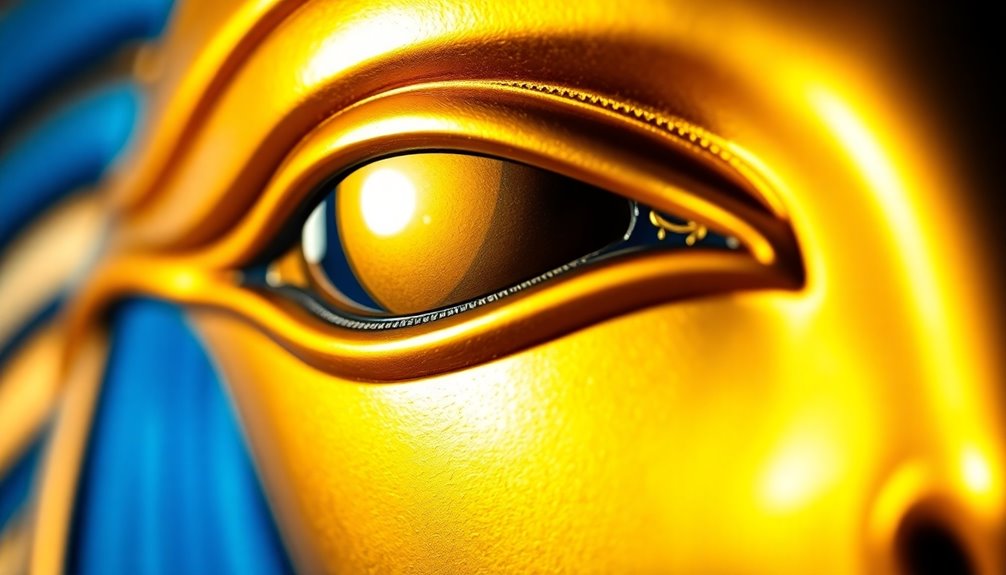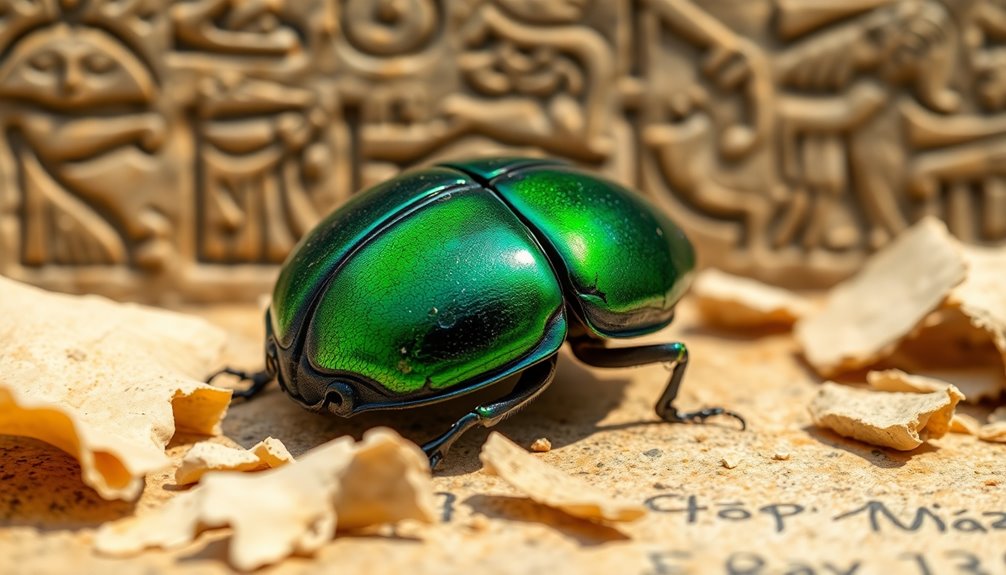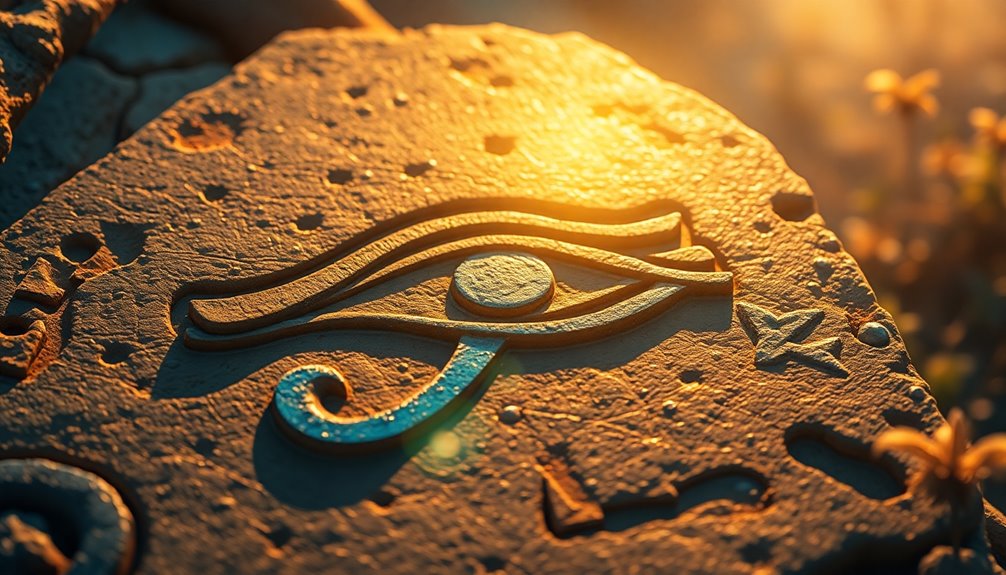The direction of the Eye of Horus changes its meaning considerably. The left eye, symbolizing the moon, embodies healing and renewal, while the right eye, representing the sun, signifies power and protection. In ancient Egyptian mythology, each eye reflects different aspects of life: the left connects to emotional recovery and compassion, while the right emphasizes strength and resilience. This distinction can affect personal interpretations and cultural significance, making it crucial to choose wisely. If you're curious about how these meanings play out in modern culture, keep exploring the fascinating layers behind this ancient symbol.
Key Takeaways
- The left Eye of Horus symbolizes healing, compassion, and renewal, while the right eye represents power, strength, and the triumph over evil.
- The direction of the Eye affects its energy; left focuses on emotional recovery, and right enhances personal power and protection.
- Each eye's unique symbolism is rooted in ancient mythology, reflecting the dualities of chaos and order in Egyptian beliefs.
- The Eye of Horus is a popular amulet, with the left eye often worn for health-related protection and the right for empowerment.
- Modern interpretations of the Eye of Horus continue to emphasize the significance of these distinctions in personal spirituality and wellness practices.
Origins of the Eye of Horus
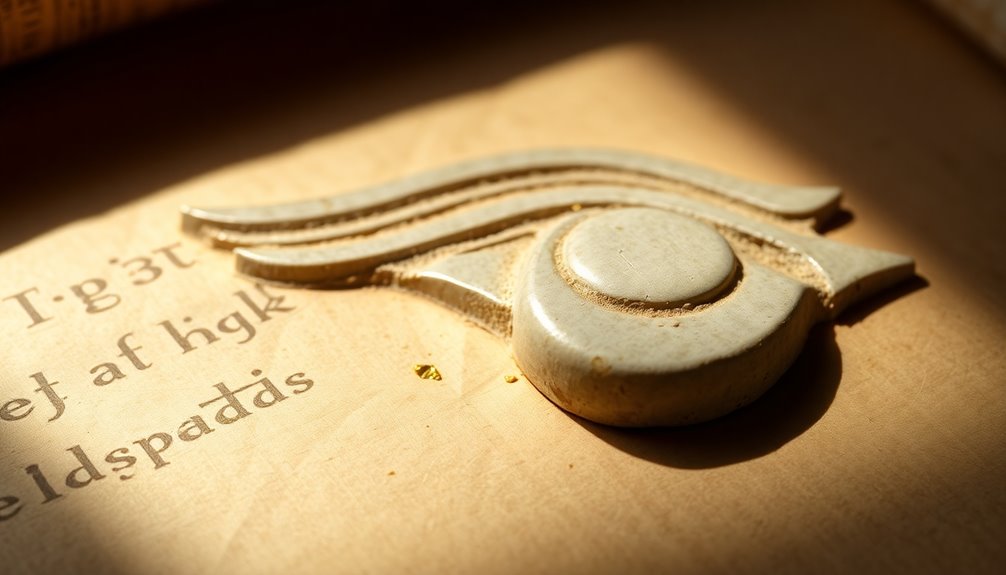
The Eye of Horus, or Wedjat, is a powerful symbol steeped in ancient Egyptian mythology. Its origins trace back to the epic battle between the god Horus and the god Set, where Horus lost his left eye. This eye, representing the moon, is linked to healing and new beginnings. After the fierce conflict, the god Thoth restored Horus's left eye, symbolizing recovery and wholeness.
As you explore the Eye of Horus symbol, you'll find it prominently featured in various artifacts and amulets throughout ancient Egypt. These items served as protective talismans for both the living and the deceased, ensuring safety and well-being in the afterlife.
The Eye of Horus has a deep significance, reflecting the themes of restoration and protection that permeate ancient Egyptian culture.
Over time, the distinction between the Eye of Horus and the Eye of Ra became clearer. Each symbol carried different meanings and divine attributes, with the left eye of Horus specifically embodying healing.
Understanding these origins enriches your appreciation for the profound impact of the Eye of Horus in ancient history and its lasting legacy.
Symbolism and Meanings
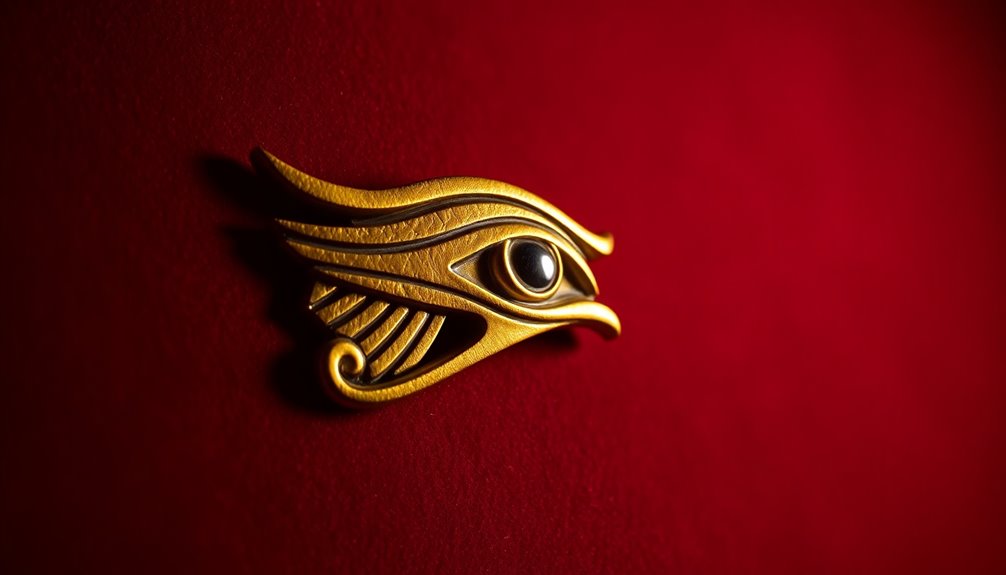
When you explore the Eye of Horus, you'll notice that each eye carries distinct meanings.
The left eye represents healing and renewal, while the right eye signifies power and the defeat of evil.
Understanding these symbols can deepen your appreciation of their significance in ancient Egyptian culture.
Left Eye Significance
Exploring the significance of the Left Eye of Horus reveals its deep connection to healing and protection. This powerful symbol is often associated with the restorative qualities of the moon, embodying the idea of recovery and wholeness.
You'll find that the Left Eye represents the process of healing, particularly because it was restored by the goddess Hathor after being lost in a fierce conflict with Seth.
In ancient Egyptian mythology, the Left Eye also signifies new beginnings, linking it to the sun's rising, which symbolizes hope and renewal. When you encounter the Left Eye of Horus in amulets and artifacts, it serves as a talisman designed to safeguard against illness and misfortune.
Many people wore these symbols to invoke protection and encourage healing in their lives.
Moreover, its significance extends into funerary practices, where it plays an essential role in ensuring the deceased's safe passage and well-being in the afterlife.
The Left Eye of Horus, consequently, stands as an important emblem of healing, protection, and the promise of renewal, guiding you through both life and death.
Right Eye Interpretation
Power and protection resonate deeply within the symbolism of the Right Eye of Horus. This eye represents the power of the sun, embodying strength and divine authority.
In ancient Egyptian mythology, it symbolizes completion and acts as a shield against evil and chaos. When you see the right eye depicted with a teardrop or cobra, it enhances its protective qualities and signifies punishment for enemies.
The right eye's orientation is linked with the setting sun, illustrating the duality of life and death and highlighting the cyclical nature of existence. People in ancient Egypt believed that wearing amulets or jewelry featuring the Right Eye could offer robust protection and strength.
Consider these key aspects of the Right Eye of Horus:
- Represents the power of the sun
- Symbolizes strength and divine authority
- Acts as a protective force against chaos
- Reflects the cyclical nature of life and death
Embracing the Right Eye can inspire you to harness its protective energy while connecting with the profound legacy of ancient Egyptian culture.
Left Eye vs. Right Eye
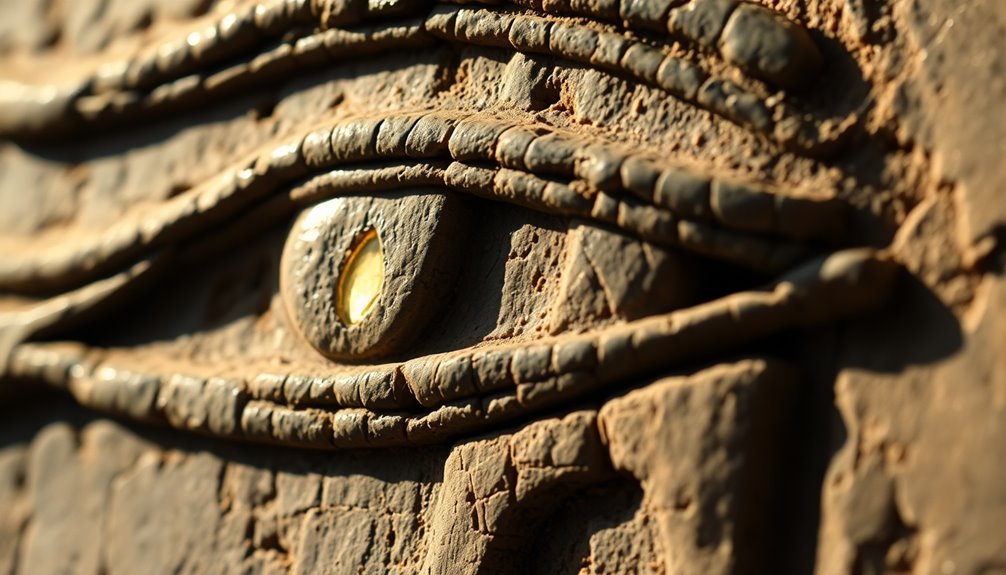
The duality of the Eyes of Horus encapsulates profound symbolism in ancient Egyptian culture, contrasting healing and protection with power and strength.
The Left Eye of Horus is your gateway to understanding compassion and renewal. It symbolizes healing, protection, and new beginnings, often linked with the moon and the rising sun. This eye represents the cycles of restoration, inviting you to embrace fresh starts and renewal.
Conversely, the Right Eye of Horus embodies power and authority. It's associated with the sun, symbolizing strength and the ability to overcome evil. When you consider the right eye, think of the fierce authority of the sun god Ra and the triumph over chaos, reflecting divine completion.
In ancient Egyptian art, the left eye features falcon-like markings, while the right eye incorporates a teardrop or cobra, showcasing diverse aspects of protection and power.
This duality emphasizes the balance between chaos and order in Egyptian thought. The Left Eye invites healing, while the Right Eye commands respect and strength. Together, they represent a harmonious balance essential to understanding ancient Egyptian beliefs.
Mythological Significance
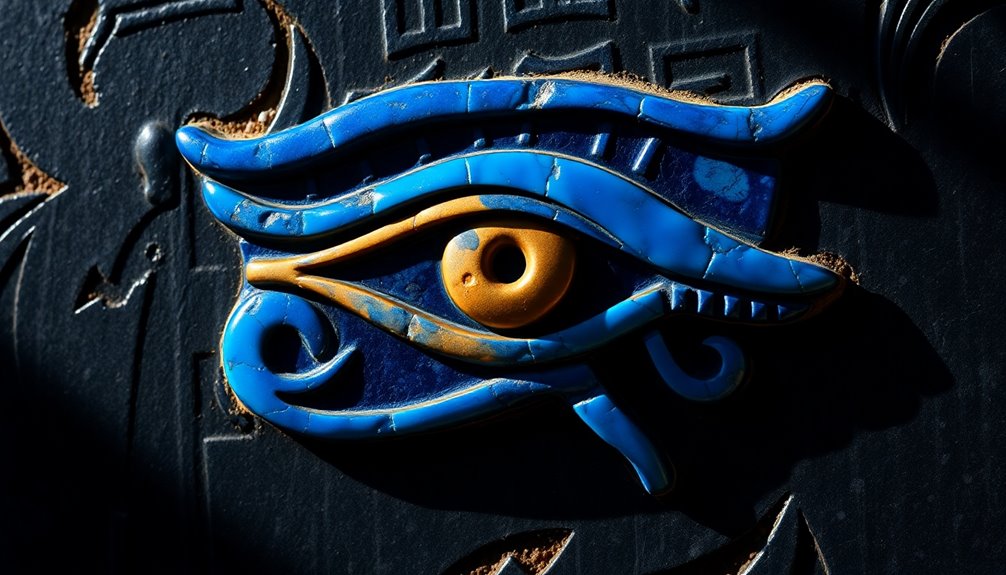
Often regarded as a powerful symbol in ancient Egyptian mythology, the Eye of Horus encapsulates themes of sacrifice, resurrection, and the balance between chaos and order. Each eye carries distinct meanings, shaping their mythological significance. The left eye represents healing, protection, and new beginnings, embodying the moon's restorative qualities. Conversely, the right eye symbolizes power, strength, and the ability to overcome evil, linked to the sun's life-giving energy.
Consider these key aspects of the Eye of Horus:
- The myth of Horus losing his left eye to Set highlights sacrifice and resurrection.
- Thoth restores Horus's eye, symbolizing recovery and wholeness.
- The duality of existence reflects the ongoing struggle between chaos and order.
- Variations in depictions emphasize the protective nature of the left eye and the authority of the right eye.
These elements reveal a complex narrative intertwined with ancient beliefs, showing how the Eye of Horus serves as a reminder of resilience and balance in the face of adversity.
Understanding this mythological significance adds depth to your appreciation of this iconic symbol.
Artistic Representations
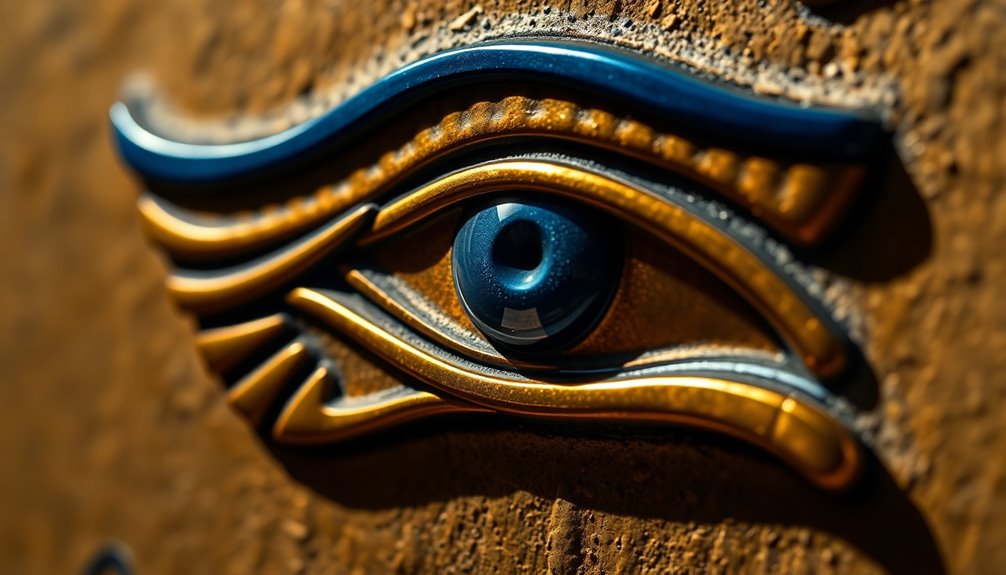
Artistic representations of the Eye of Horus vividly illustrate its multifaceted meanings rooted in ancient mythology. When you examine these representations, you'll notice distinctive markings, including a teardrop shape and a stylized eyebrow. Depending on whether it's the left or right eye, the depiction changes considerably. The left eye often emphasizes healing and protection, while the right eye embodies power and strength. This variation reflects the rich mythological narratives surrounding Horus.
In ancient Egyptian art, the Eye of Horus frequently appears in funerary contexts, symbolizing the deceased's protection and well-being in the afterlife. You can see this in various artifacts, such as amulets and jewelry, which showcase the Eye of Horus in different orientations. Each direction emphasizes its dual meanings, enhancing your understanding of its significance.
Moreover, the stylized design of the Eye of Horus incorporates elements derived from the facial markings of animals, particularly the cheetah. This connection to the divine and the natural world in artistic interpretations adds depth to its symbolism.
Whether you're drawn to its protective qualities or its representation of strength, the Eye of Horus is a powerful symbol in artistic expressions.
Practical Uses Today
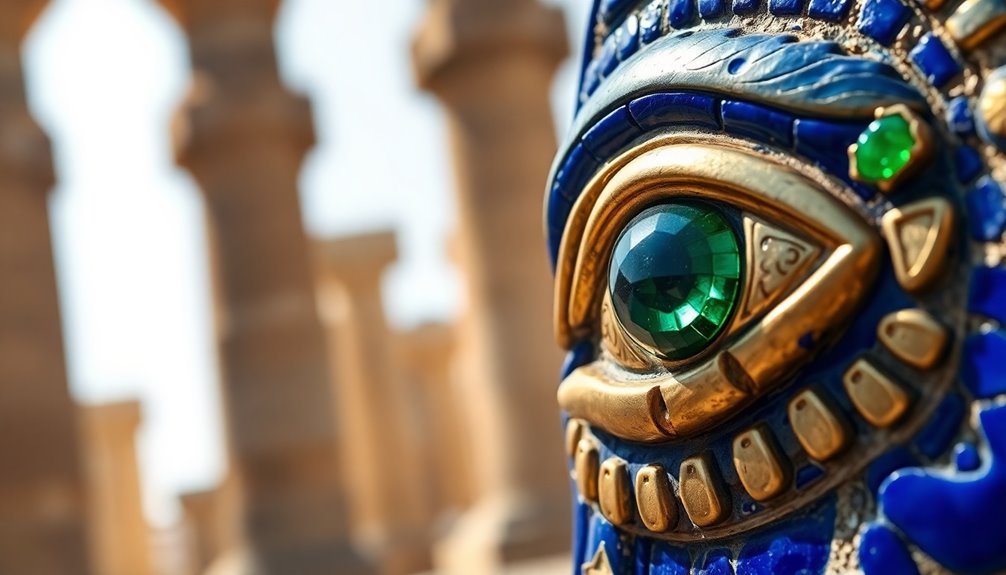
In today's world, many people wear the Eye of Horus as a meaningful accessory, believing it offers protection and positive energy. This ancient symbol has found its way into modern jewelry, with pendants and bracelets designed to promote good luck.
The direction of the Eye of Horus matters too; the left eye is thought to enhance healing and protection, while the right eye symbolizes strength and power.
You might consider incorporating the Eye of Horus into your daily life for various practical uses:
- Jewelry: Wear necklaces or bracelets featuring the Eye of Horus to amplify your spiritual connection and shield against negativity.
- Keychains: Carry keychains adorned with the Eye of Horus as portable talismans to ward off negativity and enhance your sense of security.
- Red String Bracelets: Try red string bracelets with the Eye of Horus, popular for deflecting bad energy and attracting good luck.
- Spiritual Practices: Integrate the Eye of Horus into your rituals to foster protection and positive energy during meditation or reflection.
Embrace this powerful symbol and experience its benefits in your life!
Cultural Impact and Legacy

You can see how the Eye of Horus has shaped art throughout history, reflecting its profound significance in ancient cultures.
Today, it still serves as a powerful symbol in modern jewelry and tattoos, embodying protection and healing.
This blend of historical resonance and contemporary meaning highlights the enduring legacy of this iconic emblem.
Historical Significance in Art
Throughout ancient Egyptian history, the Eye of Horus emerged as a potent symbol in art, intricately linked to themes of healing and protection. You'll notice its distinctive stylized features in various artistic representations—like the eyebrow and cheek marking—signifying its significant role in ancient Egyptian culture. This symbol wasn't just decorative; it served practical purposes as well.
- The Eye of Horus frequently appeared on coffins and tomb walls, offering protection for the deceased as they journeyed to the afterlife.
- You'll find it in temple reliefs, underscoring its significance in rituals and offerings aimed at ensuring well-being for both the living and the dead.
- Artistic representations evolved through different dynasties, reflecting changing beliefs and practices within society.
- The Eye of Horus has left a lasting legacy, influencing modern art and jewelry, showcasing its enduring power as a symbol of protection and healing.
In every era, the Eye of Horus remains an essential emblem, illustrating the depth of ancient Egyptian culture and the ongoing human quest for safety and wellness through art.
Modern Symbolism and Usage
Embracing its rich history, the Eye of Horus has seamlessly shifted into modern culture, where it symbolizes protection and healing. Today, you'll find the Eye of Horus prominently featured in jewelry and tattoos, often representing resilience and recovery. For many, it serves as a powerful reminder of strength during challenging times.
In contemporary fashion and home decor, the Eye of Horus adds aesthetic appeal while maintaining its cultural significance. Its designs attract those who appreciate ancient wisdom and mysticism, making it a popular choice across various communities.
Additionally, many spiritual practices today incorporate this symbol as a talisman to attract positive energy and ward off negativity, reinforcing its role as a source of inspiration.
As the Eye of Horus transcends its ancient Egyptian origins, it has become a universal symbol recognized around the globe. You can see how this modern symbolism resonates with people seeking deeper connections to their heritage and the world around them.
Ultimately, the Eye of Horus remains a potent emblem of protection, healing, and resilience, continuing to inspire individuals in their personal journeys.
Healing and Protection
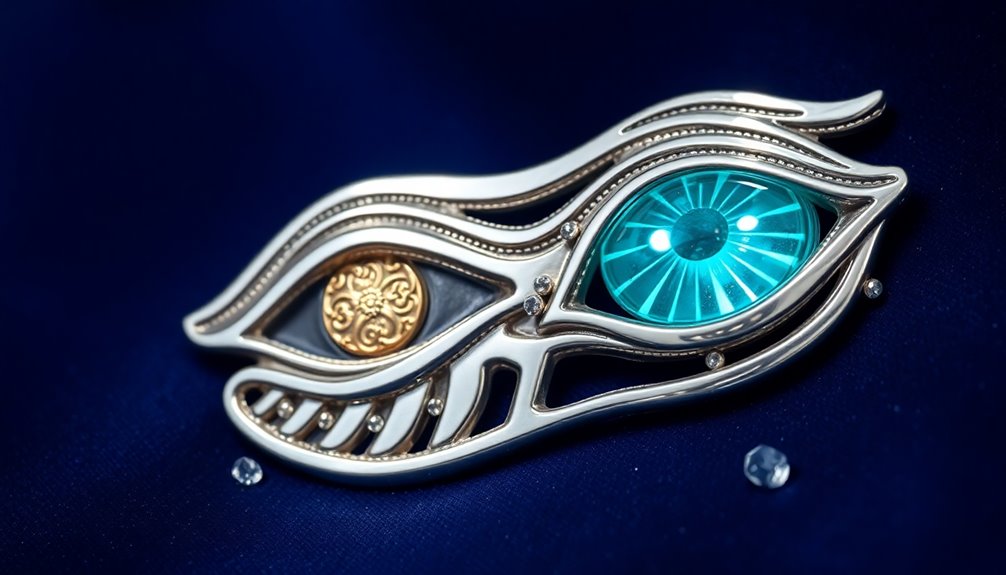
Symbolizing healing and protection, the left Eye of Horus has long been a powerful emblem in ancient Egyptian culture. This iconic symbol connects deeply with themes of recovery and renewal, often linked to the sun's rising and the restoration process after loss or injury.
Thoth, the god of wisdom, is frequently depicted as restoring Horus's left eye, emphasizing its role in completeness and healing.
Wearing amulets featuring the left Eye of Horus provided individuals with protection against illness and misfortune. This practice highlights its significance in ancient protective rituals.
Additionally, the left eye's association with lunar phases represents cycles of healing and renewal, further enhancing its protective symbolism.
Consider these key aspects of the left Eye of Horus:
- Attracts positive energy for well-being
- Promotes health and liveliness
- Serves as a talisman for safeguarding against misfortune
- Represents the cycles of healing and renewal
Modern Interpretations

When you look at the modern interpretations of the Eye of Horus, you'll notice its enduring symbolism of protection and healing.
Many people incorporate this ancient symbol into their jewelry and fashion, blending its deep roots with contemporary style.
Additionally, it plays a significant role in spiritual practices, helping individuals connect with their inner strength and resilience.
Contemporary Symbolism and Usage
The Eye of Horus has found a vibrant place in contemporary culture, transcending its ancient origins to become a popular symbol of protection and healing.
Today, people wear the Eye of Horus in various forms, from jewelry to tattoos, expressing its meanings in personal and meaningful ways.
- The left eye signifies new beginnings, while the right eye embodies strength and power.
- Many choose tattoos of the Eye as a symbol of resilience and recovery, honoring its historical significance.
- It's commonly used in meditation and holistic practices to enhance personal energy and promote well-being.
- The symbol's global recognition emphasizes its blend of ancient wisdom with modern relevance in art, fashion, and design.
- By incorporating the Eye of Horus into daily routines, individuals can cultivate an abundance mindset that transforms perceptions of wealth and prosperity.
Jewelry and Fashion Trends
Jewelry trends have embraced the Eye of Horus, blending its ancient significance with modern style. Today, you'll find the Eye of Horus represented in various jewelry forms, from necklaces to bracelets and earrings. The left eye symbolizes healing and protection, while the right eye stands for strength and power, giving you the freedom to choose what resonates with your personal journey.
Modern jewelry makers often use luxurious materials like gold, silver, and gemstones such as lapis lazuli and carnelian. These choices not only enhance the visual appeal of Eye of Horus pieces but also emphasize their spiritual properties. This trend reflects a desire for connectivity to history while maintaining a contemporary aesthetic.
Moreover, the Eye of Horus has made waves in tattoo culture, symbolizing resilience and spiritual connection. Many people opt for the eye's orientation to express their unique interpretations and experiences.
This trend ties into broader fashion movements focused on wellness and mindfulness, showcasing the Eye of Horus as a protective talisman that's just as relevant today as it was in ancient times. Whether you wear it or ink it, the Eye of Horus remains a powerful statement piece.
Spiritual Practices and Beliefs
Protection and healing are central to modern interpretations of the Eye of Horus, as many individuals incorporate this ancient symbol into their spiritual practices.
You might find that the left Eye of Horus resonates with your emotional recovery and new beginnings. Its association with the moon emphasizes intuition and your inner journey, while the right eye connects to the sun, representing action and strength.
In your spiritual practices, consider the following aspects of the Eye of Horus:
- Talisman for Protection: Use it to shield yourself from negative energies.
- Symbol of Healing: Embrace its energy for emotional and physical wellness.
- Meditation Tool: Incorporate it in rituals to connect with higher powers.
- Jewelry and Tattoos: Wear it as a reminder of resilience and balance.
Connecting With Ancient Wisdom
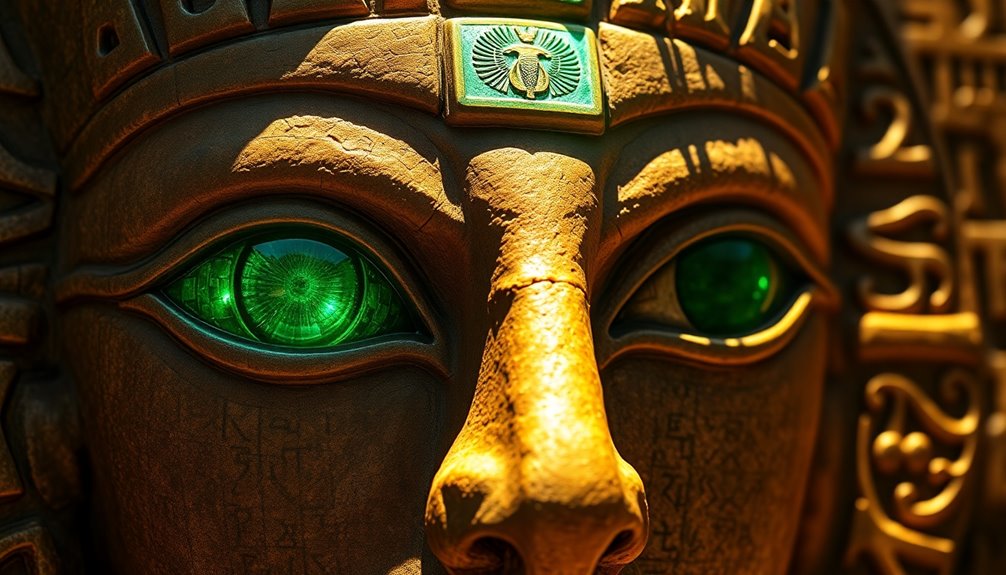
Through the Eye of Horus, you can tap into ancient wisdom that transcends time and space. Specifically, the left eye embodies healing and new beginnings, representing the restoration of Horus's eye by the goddess Hathor after a fierce battle. This symbolizes not just physical recovery but also emotional healing following trauma or loss.
The left eye connects with the moon's rising, reminding you of life's cyclical nature. It encourages you to embrace the healing process and recognize that every end can lead to a new start. Ancient Egyptians believed that aligning yourself with the Eye of Horus grants divine wisdom and protection, helping you overcome obstacles and mend emotional wounds.
Moreover, the left eye's protective symbolism is often reflected in amulets designed to shield you from negative energies, promoting overall well-being. Engaging in rituals centered around the Eye of Horus emphasizes restoration and completeness, inspiring you to seek harmony between your physical and spiritual selves.
Frequently Asked Questions
What Is the Difference Between the Left and Right Eye of Horus?
The left and right eyes of Horus symbolize different aspects of life. The left eye represents healing and protection, while the right eye embodies power and strength.
If you're seeking restoration after loss, the left eye's energy is what you need. Conversely, if you're aiming to overcome challenges and assert your authority, the right eye will guide you.
Each eye serves a unique purpose, reflecting the dual nature of experience and personal growth.
Is the Eye of Ra Left or Right?
Imagine scrolling through an ancient Egyptian scroll, and you'll see the Eye of Ra, which is represented as the right eye.
It symbolizes the sun and embodies divine authority and power. This eye, often paired with a cobra or teardrop, showcases the life-giving yet destructive nature of sunlight.
Unlike the left Eye of Horus, the Eye of Ra highlights order and protection, reflecting its essential role as a defender against chaos.
What Are the Sides of the Eye of Horus?
The Eye of Horus has two sides: the left eye and the right eye.
You'll find that the left eye symbolizes healing and new beginnings, while the right eye represents power and strength.
Each side carries unique meanings and reflects different aspects of ancient Egyptian mythology.
Depending on which side you focus on, you can tap into its protective or empowering qualities, making it significant for your spiritual or personal journey.
What Does the Bible Say About the Eye of Horus?
The Eye of Horus might as well be the most mysterious symbol ever, yet the Bible doesn't mention it directly.
Instead, you'll find themes of protection and healing that resonate with its symbolism.
While the Bible warns against idolatry, it acknowledges the cultural influences of its time.
You can appreciate how the Eye's representation of good battling evil aligns with biblical narratives of God's ultimate victory over darkness.
Conclusion
In exploring the Eye of Horus, you've revealed layers of meaning that go far beyond its striking design. But wait—what if the direction shifts your understanding entirely? The left eye hints at intuition and mystery, while the right embodies clarity and power. Each glance reveals a new facet of ancient wisdom, beckoning you to investigate further. As you ponder this duality, remember: the choice of direction might just uncover secrets you never knew existed.

